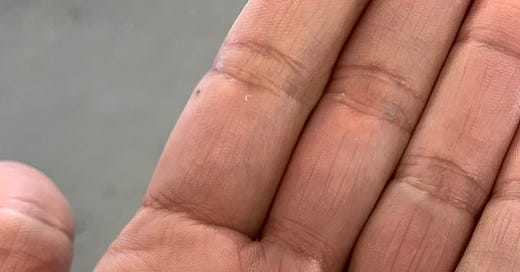1. “Things have a life of their own," the gypsy proclaimed with a harsh accent. "It's simply a matter of waking up their souls.”
― Gabriel García Márquez, One Hundred Years of Solitude
A group of friends and I were discussing books that had been influential in our lives. When asked, I cited 100 Years of Solitude by Gabriel Garcia Marquez for its glorious circular narrative and recapitulation of Latin American history, from banana men to endless wars to archetypes that repeat and repeat. When 100 Years found me, I was 16 and living in Paraguay, participating in a service-learning project. It would be three years before my hands touched gold, but the characters of the alchemist and, later, the goldsmith must have planted a seed of understanding that gold is a circular material. Colonel Aureliano Buendia, one of the two Buendia sons, was famous for fighting endless wars and fathering 17 sons but in his later years, he returned home to Macondo and found solace in making gold fish, selling them and using the money to purchase more gold to make more fish. Frustrated by people’s reasons for buying his jewelry, Colonel Aureliano Buendia decides to make and remelt the fish, lost in an endless cycle of making. The object of the exercise is not to make a thing but to keep the pool of material moving like a fish jumping out of the water and diving back in.
2. London Spot Price
Today the price of gold is $2654.90/ Troy Ounce or 85 dollars/gram. For those of you with a stash of gold coins under your mattresses, now is a good time to unearth them. Gold has never been higher and it may have further to go. For goldsmiths selling their golden objects, the rise in the price of gold has been unrelenting. Here, we have the artisan at the mercy of large corporations buying gold for investment purposes, as well as cell phones, computer processors, and nanotechnology. As a maker of gold objects, the current landscape is a struggle, although as a material historian, I find the assertion of gold in our daily lives fascinating. Science uses gold precisely for the reasons that goldsmiths have long considered: reflection, conduction, malleability, plasticity, ductility, and resistance to corrosion.
3. Nanoparticles/Stardust
I’d like to be cured by gold. Six years ago, I finished radiation therapy for breast cancer. The image my radiation oncologist presented to me was a glowing mop, wiping up any errant cancer cells that had skillfully avoided chemotherapy and surgery. The mop analogy is useful. It brings the very space-age experience of the radiation pod back to the hands, to cleaning. But had he presented me with the option of gold nanoparticles, glimmering shields absorbing radiation, and creating internal fireworks of cancer combustion, I might have resisted less?
When radiation interacts with these gold nanoparticles, there is a secondary electron shower. This means there is a local dose enhancement of radiation. As a result, you can apply less radiation to the tissue, but the nanoparticles will amplify the effects of the radiation to kill the cancer cells and to spare the surrounding normal tissues. (Text from MD Anderson, linked)
4. Thoughts on Making
A bit of lore that I absorbed during a year studying in Italy was that in the city of Padua, they filter the water to catch gold. “Make work that is like trying to hold water in your hands”, a teacher of mine instructed. In both of these images, a desire to catch a fleeting, precious material, to extract the poem from an ocean of words.
The sense that material is moving is what moves me to make and unmake. A goldsmith transforms material with relative ease. Controlled flames undo most things. As a maker of objects, I have navigated the waters of sentiment and studied the point when an object becomes a beloved object. And I have undone those objects, melting them, reforming them, erasing their stories, and beginning a new one.
I want to understand how materials perform physically and poetically. I often work with gold because it is a sustainable material, which means that I begin in the middle, start a piece with the scraps of another, and string together shards of many works to make a new thing. I explore plasticity and refinement. I want to understand how far a material can be pushed before it breaks. No material is static. With this in mind, I skirt the edge of the scrap yard, the rim of the crucible.
5. Rumi and the Goldsmith
You are a mountain full of gold.
Open the mine. Let the mountain speak.
Hear what happens.
-Jalaleddin Muhammad Rumi Translation: Haleh Liza Gafori (Gold, (42).The story goes that Rumi, the beloved 13th-century Sufi poet, began to whirl and dance at the sound of the goldsmith’s hammer and, afterward, he sang out poetry in the form of ghazals that carried in them the beat of the hammer.
Hammers are percussion. They keep rhythm. When forging, I keep my body soft but aligned. I raise the hammer and let it fall, striking metal atop the anvil. The mind goes quiet until the metal ceases to move with the hammer blows. The trance is broken, the metal is heated, and the dance begins again.
6. On Searching
The search for gold is a story as old as hunger. Its elements: mercury, gold, greed, and violence, are the protagonists of myths and stories throughout time and across cultures. Searching for gold has led to voyages along the surface of the earth and into the depths with contemporary gold mining taking place in the deep sea, in more traditional mines, and in alluvial deposits throughout the world. While extraction technology has improved, demand for gold continues to rise. Finding gold, even small grains of it, represents a path forward economically where none existed before.
7. Goldsmithing and Sustainability
Goldsmithing has historically been a “cradle to cradle” craft with precious metal and gemstones often being repurposed to make new jewelry objects. As William McDonough argues in his seminal work of design theory, “If we think about things having multiple lives, cradle to cradle, we could design things that can go back to either nature or back to industry forever.” (McDonough, 2005; TED, 2005) These very characteristics of goldsmithing can make the provenance of gold in a particular piece of jewelry difficult to trace. Gold can be easily melted down, brought through a physical transformation, from solid to liquid back to solid within a matter of seconds and with only a basic torch. This makes gold a tricky material to trace back to the source which could be a mine, pawn shop, or long-ago cultural erasure.






